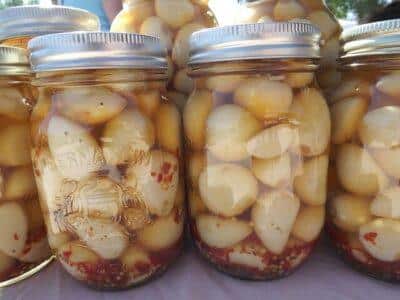|
Listen To The Article
|
Canning is a fun and rewarding summertime activity that helps preserve your garden’s bounty, saves money and increases your self-reliance.
But it also involves work at a hot stove during the hottest part of the year, when fruit and produce are at their peak. Back in the day, when cooking was done on wood cook stoves, many households had a second detached “summer kitchen,” where summer meals were prepared without adding extra heat into the house.
Outdoor summer kitchens are mostly a thing of the past, but serious home preservers and canners can set up an outdoor “canning kitchen” to make their jams, jellies and preserves.
Basic Setup
While you can use an old-fashioned wood cook stove to equip your canning kitchen, most people opt for the convenience of large portable propane burners. A simple high output propane burner (55,000 BTU or more) is available for under $40, and can connect to a standard exchangeable propane tank. These large burners can bring a five-gallon pot of water to a rolling boil in just a few minutes, which beats waiting as much as an hour for your indoor kitchen stove to do the same job.
‘Miracle Oil Maker’ Lets You Make Fresh Nut Oils Within Minutes!
A second, small scale camp stove to cook up your preserves is a necessary expense, as a high output burner would quickly burn preserves and wreak havoc on your small saucepans. These are similarly inexpensive and sell for as little as $20.
Assuming you already have canning jars and pots, the only other thing you’ll need is a propane tank for about $40. All total, for about $100 you have the basics of an outdoor canning kitchen that can be set up temporarily outdoors on a small table or even the ground in a pinch. With even a few batches of jam or pickles in a summer, you’ll be thankful for the investment, both for the cooler house and the reduction in humidity and mold potential, as all that water bath steam is released into your kitchen.
Canning on Wood Heat
If you’d like to further reduce your ongoing costs, or simply avoid the use of fossil fuels, it’s easy enough to can outdoors on wood heat, or with a hybrid method. For the least expensive option, try creating a small wood stove by making a U-shaped fire pit out of cinder blocks and topping it with a BBQ grate. With this setup, you’ll need to be careful not to damage your canning pot with the open flame. For a less primitive option, try a wood cook stove, which you can get, second-hand, for as little as a few hundred dollars.
If you’re truly looking for the best long-term outdoor canning kitchen solution, try a dual-fuel wood and gas stove. With a dual-fuel stove, you’ll be able to use wood as your primary heat source to bring canning water to a boil, but still use a more gentle heat from a small gas burner to gently cook down jams and jellies before they go into the water bath.
Temporary or Permanent Canning Kitchen
It’s easy enough to set up a temporary canning kitchen for the afternoon by simply hauling your propane burners out to a safe spot, but if you’re canning more frequently, it might make sense to set up a semi-permanent or permanent canning kitchen.
A semi-permanent option with a tarp or tent canopy roof means that you can leave your materials outdoors and can several times a week without exhaustive setup time. A simple sink built into a 2×4 framed countertop can be plumbed in with a garden hose. With this option, you’re still at the mercy of the weather to some degree, as tarps don’t fare particularly well in high winds and storms — and flies, honeybees or mosquitoes are sure to be a problem.
If you can afford it, the best option is a permanent screened-in outdoor structure that has a solid roof and fully screened walls to protect you from the elements and unwanted pests. Keep in mind: If you set everything up correctly, you could do just about all of your summer cooking in your outdoor canning kitchen to help keep your house cooler.
For a truly year-round option, try integrating your canning kitchen into a sugar shack. A sugar shack is already set up to vent heat and steam, and most are designed with a bit of counter space for making value-added maple products like maple cream and candy. If you’re considering building a sugar shack or summer canning kitchen, why not design them together into one structure to save both space and money?
Do you have an outdoor kitchen? Share your ideas for one in the section below:
 Off The Grid News Better Ideas For Off The Grid Living
Off The Grid News Better Ideas For Off The Grid Living





